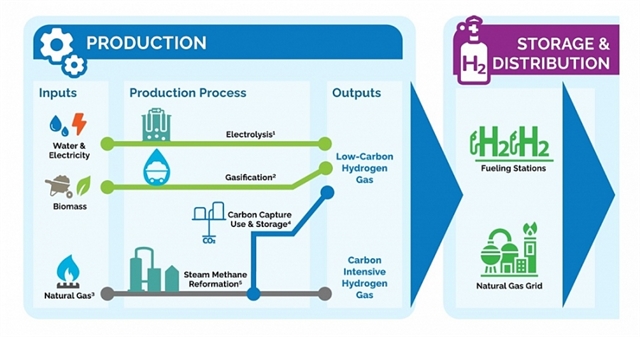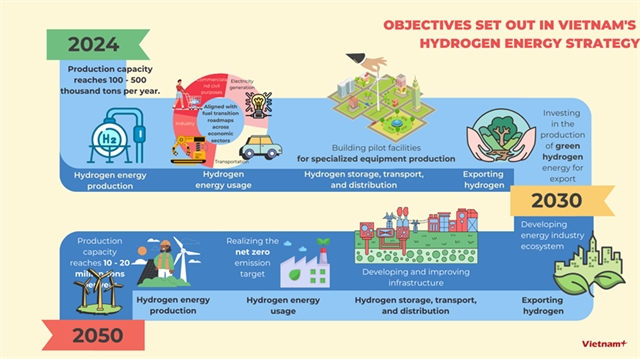 Opinion
Opinion


|
| Võ Thanh Tùng, energy advisor of PtX Outreach Project of German Agency for International Cooperation. Photo courtesy of GIZ |
Việt Nam News reporter Khánh Dương speaks to Võ Thanh Tùng, energy advisor of PtX Outreach Project of German Agency for International Cooperation (GIZ) about Việt Nam’s national strategy on hydrogen energy development.
Việt Nam has recently approved the Hydrogen Energy Strategy to develop the energy industry in a green, clean and sustainable manner. How do you assess Việt Nam’s potential in achieving this?
Việt Nam possesses great potential to develop the hydrogen industry. With abundant renewable energy sources such as solar power up to 300 GW or offshore wind power up to 600 GW, we can take advantage to promote the green hydrogen industry’s development through the application of advanced technologies such as water electrolysis.
Recent advances that allow the production of hydrogen from seawater are extremely important factors, creating favourable conditions for us to build complexes for offshore wind power production and at the same time provide electricity for electrolysis equipment to produce hydrogen from seawater.
Currently, the annual hydrogen output produced for the domestic market is about 500,000 tonnes. But hydrogen is produced mainly from fossil fuels such as coal or natural gas.
Việt Nam not only needs to produce low-emission hydrogen to replace current market demand, but also must expand the market and boost demand from difficult-to-develop industries such as electricity, transportation (including aviation, waterways, road transport), heavy industry such as metallurgy, petrochemical refining or chemical production. This is also an important key to developing the hydrogen industry.
Việt Nam can also make good use of its geographical location to provide green hydrogen to global and regional markets, meeting the needs of countries wishing to import hydrogen products.
These are important directions that are also mentioned in the new national hydrogen energy strategy approved by the Prime Minister.
These important policy directions will serve as important premises to help management agencies and investors take appropriate steps to concretise potential into high-tech projects with commercial and economical efficiency.

|
| Green hydrogen is produced through water electrolysis, in which electricity is used to split water into hydrogen and oxygen. Photo ontario.ca |
How important is hydrogen in helping Việt Nam realise the green energy transition goal and net zero emission target by 2050?
Green hydrogen plays an important role in the energy transition, realising the commitment to carbon neutrality by mid-century.
According to estimates by a number of reputable organisations, the proportion of renewable energy has continuously increased in the global electricity system. However by the end of 2022 this proportion was estimated at approximately 30 per cent and the process of reducing emissions has achieved limited results.
That’s simply because the electricity industry only contributes about 40 per cent of global emissions while the remaining 60 per cent comes from manufacturing and processing industries such as metallurgy, chemical manufacturing or transportation including aviation and waterways.
That's why the world is considering the green hydrogen industry as one of the important solutions to solving the carbon neutrality problem by mid-century.
Việt Nam is in a similar situation. We will not be able to achieve the carbon neutral goal if we do not promote the hydrogen industry in order to provide products for industries that are difficult to emit emissions such as transportation, heavy industries (metallurgy, chemicals and petrochemical refining).

|
| Key objectives set out in Việt Nam's hydrogen energy strategy. Infographics Vietnamplus.vn |
What are the key challenges Việt Nam will face while developing hydrogen?
To develop a new industry like hydrogen, of course there will be numerous challenges that we will encounter. I only mention a few main challenges.
First of all, that is market development. Because it is a completely new industry, there is currently no demand for the product. Of course, investors will consider choosing whether to participate in the market or not, especially when it is difficult for new products to immediately compete with traditional fossil fuels such as oil and coal in terms of price.
In many countries, to promote the market, governments need to have appropriate mechanisms to support businesses and investors to participate in the market and help shorten the gaps of green hydrogen production costs and increase competitiveness with other fuels.
Amid domestic market’s various limitations and uncertainties, promoting exports is a reasonable direction, aiming to access potential markets with great demand.
The State needs to have appropriate policies to promote and encourage domestic and foreign investors to participate in the export-oriented market.
Pioneering export enterprises are also the driving force to promote the domestic market’s development, creating products suitable to the needs of the domestic market in the future.
I also want to mention infrastructure. Việt Nam now only has infrastructure for the gas industry, but not for the hydrogen industry.
To develop this industry, it is clearly necessary to build a synchronous infrastructure system, from power supply, to transportation, storage, and warehouses. Building an infrastructure system is an especially important task when we know the cost of transporting hydrogen is very high.
Effective planning, increasing the ability to connect between production areas and consumption areas play a decisive role in the industry’s development.
Taking advantage of the oil and gas industry's current infrastructure system is also a problem that needs an early solution to help minimise investment costs and ensure the rapid growth of the hydrogen industry.
Policy mechanisms are also important.
The launch of the hydrogen strategy has opened up an important direction for the industry to develop sustainably, effectively, and competitively.
Việt Nam needs to have consistent and reasonable policies to attract investment, develop markets, and build infrastructure. This is both a requirement and an important challenge that the hydrogen industry needs to address, eliminate bottlenecks, and clear capital flows for development.

|
| Việt Nam’s first and largest green hydrogen factory was inaugurated in March 2023 in the Mekong Delta province of Trà Vinh’s Duyên Hải District, with total investment of VNĐ8 trillion (US$341 million). Covering an area of 21ha, the project is expected to become operational after two years, initially producing 24,000 tonnes of green hydrogen and 195,000 tonnes of oxygen a year. VNA/VNS Photo Thanh Hòa |
The Vietnamese Minister of Industry and Trade Nguyễn Hồng Diên has highlighted the roles of international partners in sharing experience, technology and training human resources for hydrogen development in Việt Nam. How has GIZ supported Việt Nam in energy transition and implementing the Hydrogen Energy Strategy?
We, as the German Agency for International Cooperation, have accompanied the Vietnamese government to develop the hydrogen industry.
Over the years, we have supported the organisation of training programmes to improve professional knowledge at Government agencies, State-owned enterprises and private companies.
We have also carried out a number of research consulting activities, thereby seeing the potential benefits of the industry not only in environmental issues but also in economic development.
We will continue to accompany the Vietnamese Government to support policy framework development, capacity building, knowledge and technology enhancement as well as support businesses in building strategies to promote the energy transition process as well as develop a sustainable and effective hydrogen market. VNS




